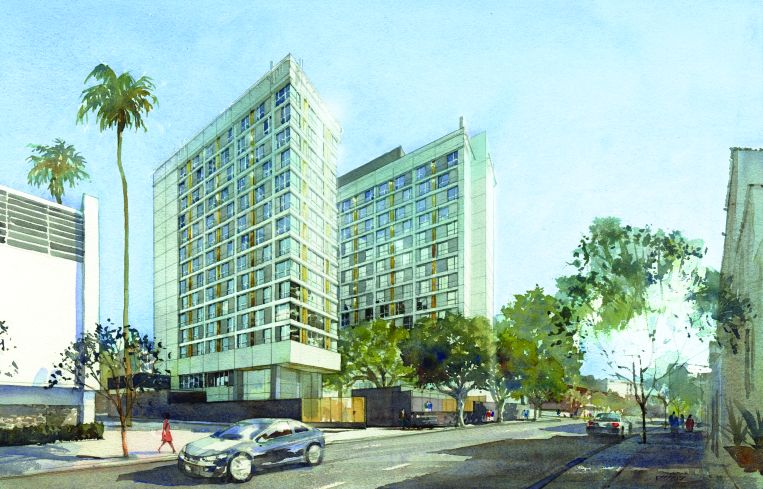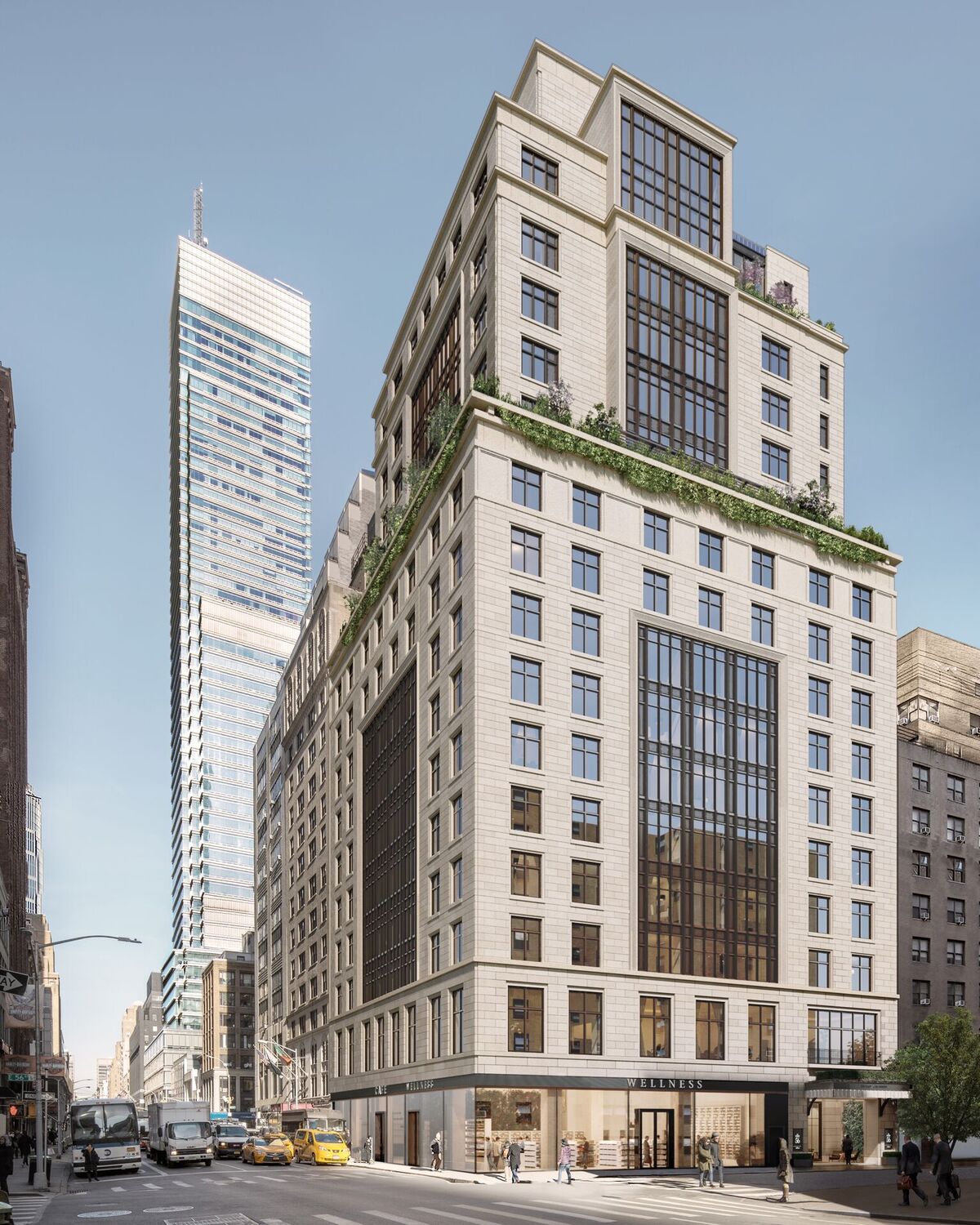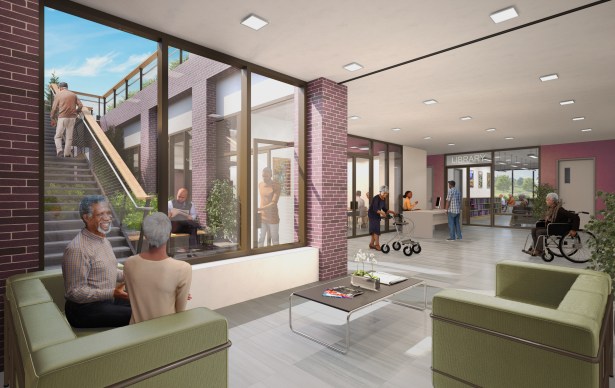Senior Moment: The Time Is Ripe for Lending on Housing for the Aged
New luxury development trends have seniors tasting the added perks of millennial multifamily amenities
By Mack Burke and Lauren Elkies Schram September 18, 2018 10:30 am
reprints
It’s a bet that a lot of financiers feel they cannot lose. The baby boomers are retiring. The aging population has grown. They’re going to need somewhere to live.
Whether funding new projects or refinancing old construction debt, lenders of all shapes and sizes are putting up money on seniors living assets.
Alternative lender Acore Capital is one such lender who has increased its presence in the space, completing a handful of senior housing transactions over the last year, according to the company co-Founder and Managing Partner Chris Tokarski.
“ACORE is very bullish on the senior housing sector given the favorable demographic trends and projected needs of the aging baby-boomer population,” Lance Wright, a managing director at ACORE, said recently in prepared remarks.
The debt fund recently lent $34.4 million to Cadence Senior Living for the acquisition and renovation of a 158-unit assisted living senior housing property called Marymount Greenhills, in Millbrae, Calif.
“The deals we’re seeing are coming out of construction loans, and for us, as a floating-rate lender, doing three- to five-year bridge loans, most borrowers are willing to take [that kind of deal],” Tokarski said.
The populations of seniors across the country are rising thanks to the retirement of the baby boomers, experts said. And housing is especially in demand in urban areas, as residents want to be in close proximity to the action in order to avoid reliance on a car.
According to a January 2016 report from the nonprofit Population Reference Bureau, “The number of Americans ages 65 and older is projected to more than double from 46 million today to over 98 million by 2060, and the 65-and-older age group’s share of the total population will rise to nearly 24 percent from 15 percent.”
Alternative and middle-market lenders, banks and agencies who spoke to Commercial Observer said that they’re following clients and sponsors to opportunities across the country but staying away from new sponsor entrants who haven’t demonstrated a clear track record or the capacity to expand operations at a senior living project.
It’s just good sense. According to the NCREIF Property Index, as cited in CBRE’s Summer 2018 Seniors Housing & Care Investor Survey, the annual return for seniors housing came in at 11.6 percent in the second quarter, down from 12.8 percent in the first quarter. That’s much higher than the annual 7.2 percent return generated by all other asset classes combined.
As one would expect, government-sponsored entities such as Fannie Mae and Freddie Mac are deeply involved in the market, examining a variety of senior living deals across the country as they look to fill gaps in the marketplace. Jonathan Rose Companies, for example, relies on Federal Housing Administration, Fannie Mae and Freddie Mac loans for affordable and mixed-income multifamily senior housing.
According to Phyllis Klein, a vice president of multifamily customer engagement at Fannie Mae, the agency focuses on stabilized senior assets with strong sponsorship and fundamentals.
“We really like the seniors housing space,” Klein said. “We’ve been in the business for close to 25 years and it’s been done with very low credit defaults. We’re involved in all levels of product, but probably not as much at the upper end.”
Fannie Mae has stayed away from financing skilled nursing facilities, concerned about the need to retain licensed nurses and professionals on site. It’s opted for independent living, assisted living and memory care projects or developments that incorporate all three components.
“We do see a lot of new product, and what we’re seeing is we’re in a time when people are building into the tsunami wave coming into the seniors living space,” Klein said. “Maybe it’s a bit too early, but it’s not creating issues from our standpoint; we look at deals on an individual basis while gauging the competitive environment.”
In terms of what structure Fannie Mae looks for in a deal, Klein said, “it ranges from the owners’ lease structures to whether an operator is in a joint venture with a private equity player or another sponsor that will have some skin in the game.”
“Senior housing was more of a niche before and now it’s part of every private equity fund portfolio,” said David Freshwater, the chairman of Watermark Retirement Communities, which has 52 senior housing communities and 9,400 beds in 21 states. Prior to the recession, he explained, private equity firms didn’t invest in them, so deal sizes were smaller. The senior housing industry, Freshwater said, has a “long maturity and a good track record.”
His firm has partnered with Florida-based private equity firm Kayne Anderson Real Estate Advisors for the Watermark at Brooklyn Heights. Kayne Anderson plunked down $202.5 million for the real estate, at 21 Clark Street in Brooklyn and is investing another $125-plus million for its conversion to a senior facility. The 15-story (plus 16th-story rooftop terrace), 315,000-square-foot project will appeal to a high-end clientele. It will have around 270 market-rate units providing various levels of care from independent living to assisted living to memory care when it opens in 2020.
Market-rate senior housing has been more recession-proof than other types of housing.
“In 2008 and 2009 with the recession, senior housing did better than all other real estate asset classes so while we did have our issues with one or two communities, by and large we came out of the recession pretty much unscathed,” Freshwater said.
Part of the success, he added, can be attributed to the fact that “it’s more need generated. The industry did well, so we became—as an industry—more attractive. It became its own space, like apartment and hotel spaces.”
According to CBRE’s Summer 2018 Seniors Housing & Care Investor Survey, 64 percent of investors in the space plan to expand their senior living portfolios by next summer; independent living was identified as the most popular investment going forward, according to the survey. This comes after investment volume in senior housing climbed 27.3 percent on the year in the second quarter, per CBRE.
“One of big things we’ve seen in senior housing is that the demand on the investors’ side has increased substantially,” said Scott Alter, a co-founder and principal of Standard Companies, a full-service investment and asset management firm which creates affordable senior housing through rehabilitation of properties. “It’s a very desirable investment class.” Standard Companies has a little over 2,000 affordable units for seniors nationwide, with another 1,500 units in contract.
The aging population, Alter said, provides a great demand on the rental side of the business and “on top of that, seniors are generally easier to manage than families. If you ever see a 10-year-old running down the street they’re going to make more of a ruckus than a 70-year-old.”
But according to Zach Bowyer, a senior managing director of valuation and advisory services at CBRE, senior housing valuations will be challenged in the near term by the trifecta of new supply outpacing demand, rising operating and development costs and rising interest rates.
“These challenges will be relatively short-lived as the sector prepares for the next wave,” he said in a statement. “As market participants search for innovative ways to differentiate through innovative design trends, operations, services and technology, sound property-level operations remain critical to maintaining valuations.”
Few of those with whom CO spoke seemed to feel that oversaturation was a problem, and the eagerness to jump into the market stretched across all kinds of lenders.
“The typical [lender] roster is seven to 10 super-active construction lenders out there, with probably a 50-50 split between traditional banks and funds,” said Silverback Development Founder and Principal Josh Schuster. “The funds want higher leverage for a higher interest rate to quantify their risk profiles, but the lower leverage and cheaper cost of capital from banks may include a principal repayment recourse; we tend to stay away from that.”
Schuster himself is currently in the process of locking in a construction lender on a planned 122,000-square-foot, 110-unit luxury senior living development at 212 Wadsworth Avenue at West 184th Street in Washington Heights. He wouldn’t disclose which lenders are in the running to finance the roughly $50 million development.
Freshwater’s Watermark only builds market-rate senior housing. Another one of its developments underway is in the Westside region of Los Angeles, The Watermark at Westwood Village. Costing over a couple hundred million dollars, the 14-story 188-unit building at 947 Tiverton Avenue in Westwood Village will be complete in early 2020.
“People aren’t living with sons, daughters and grandkids. They want to be more independent,” Freshwater said.
This category of “independent living” isn’t cheap. It generally costs residents between $3,000 and $6,000 a month, and cost doubles in New York City or in places like Beverly Hills in Los Angeles, Freshwater said. Assisted living or memory care runs $4,000 to $8,000 depending on the level of service, apartment size and view. Again, double that if you’re looking in New York City.

Another market-rate senior housing project coming to New York City is one from Hines, a global developer and investor, and Welltower, a health care real estate investment trust, and a third unnamed institutional investor. They are erecting a 16-story building at 139 East 56th Street for an assisted living and memory care community. Called Sunrise at East 56th, the 130,000-square-foot property will include 151 units (primarily studios) when completed in early 2020. Construction commenced this March.
This is the first senior housing project globally for Hines, with more expected in the future, said Sarah Hawkins, a senior managing director at the firm, who is working on Sunrise at East 56th.
The Hines-Welltower partnership launched when the latter approached Hines in early 2015 to build senior housing in New York City.
“We have a pretty extensive residential platform across the country,” Hawkins said. “It felt like such a natural extension of what we have been doing.”
Omega Healthcare Investors and Maplewood Senior Living are working together to develop Inspīr Manhattan, a 23-story, 215-unit and 212,000-square-foot assisted living memory care building at 1802 Second Avenue between East 93rd and East 94th Streets. Expected to cost $260 million, the developers are calling the property “modern senior living.” The development is slated to open in 2019.
Of course, these market-rate upscale senior facilities only work for the types of seniors that have ample cash resources.
On the lower end of the scale, the general housing affordability crisis is hitting senior citizens harder than other cohorts because they are living a long time with less income.
“Some people are kind of stuck,” said Mark Fogel, the president and CEO of ACRES Capital, a middle-market lender based in Long Island, N.Y. “What you’re seeing is people staying in the same areas and just downsizing to something cheaper, like selling a house and taking equity out of that and going somewhere more affordable in the same area.”
And many seniors may not have the wherewithal to move thousands of miles away from home.
“We’re seeing demand for it in places like Cleveland and Chicago, where people just don’t want to leave their hometowns,” Fogel said. “We looked at a couple ground-up construction and assisted living and independent seniors in Midwestern markets where not everyone wants to be in the sunshine and near golf courses.”
According to senior housing data from Marcus & Millichap on the second half of 2018, occupancy in stabilized senior housing in the Midwest, the Mid-Atlantic and the Northeast markets are outpacing that of the typical hotspots in Florida and in the Southwest, where there’s a higher rate of population growth expected for the 65 and over age bracket.
To encourage the development of affordable senior housing, city, state and federal governments have provided various incentives. In New York City, the de Blasio Administration has committed to creating or preserving 30,000 senior households by 2026 under the Housing New York plan. New York City Department of Housing Preservation & Development finances the construction of senior housing through the Senior Affordable Rental Apartments (SARA) Program, which provides gap financing in the form of low interest loans to support the construction and renovation of affordable housing for seniors 62-plus years in age with low income.
Beyond New York, the U.S. Department of Housing and Urban Development (HUD) provides interest-free capital advances to private, nonprofit sponsors to finance the development of supportive housing for the elderly.
To help seniors age in place, developers are including senior services at the base of buildings with housing above.
“That is a nice combination,” said Christine Hunter, a principal of Magnusson Architecture and Planning. The firm designs independent affordable housing for seniors in the New York metro area and smaller upstate cities, including one under construction at 771-775 Crotona Park North in the Bronx for Help USA. The building includes a ground-floor senior center to be run by SAGE, a nonprofit which advocates and provides services for LGBT elders.

“Everybody’s aware that to successfully let seniors age in place, most people will need some kind of assistance or service if they get old and frail,” Hunter said. “So, there’s a desire to create housing where some of those services are readily available.”
In Jonathan Rose Companies’ projects, the firm is providing onsite medical exam rooms where doctors may meet with patients, as well as community gardens and exercise rooms with senior-appropriate workout machines.
The company is one of the larger owners of affordable independent senior rental housing around the country, and, according to calculations by Jonathan Rose, the founder and president of the firm, the 10th largest owner of affordable seniors housing overall. The company owns 14,565 units, of which about half—7,770—are homes for seniors.
Rose said his company’s emphasis is not on building senior housing but on bringing seniors “community engagement.”
“We’re working on how to bring health care providers onsite to residents, which is a much lower cost than seeing people in hospitals for health care providers and patients,” he said.
In Sunset Park and Bay Ridge, Brooklyn, Jonathan Rose Companies will close shortly on three affordable senior housing projects. These will be the firm’s first properties exclusively for seniors in New York City. Rose will work with a nonprofit partner to continue to provide health and social services to residents after closing.
Beyond allowing seniors to age in place, for-profit developers are souping up properties to the point that they resemble flashy condominiums.
At the 189,000-square-foot Watermark at Brooklyn Heights, there will be over 50,000 square feet of amenities spanning the subcellar, cellar, first floor and rooftop. Amenities will include a library and lounge, an art studio, a sunroom, an auditorium, a fitness center and pool, a wellness clinic, a beauty salon, performing arts space, concierge services, a main dining room and a casual dining room and a bar.
“We’ll be one of the most amenitized senior housing projects in the country,” Freshwater said.
The days of old, boring nursing homes are gone.
At Sunrise at East 56th, where the average resident will be 85, its large-scale dining room with private dining, housekeeping and programming make it “really a lot more like a hotel,” Hawkins said.
Fogel added, “It’s almost like seniors are seeing what the millennials have been getting [in multifamily amenities] and are like, ‘we want that for ourselves.’ ”



